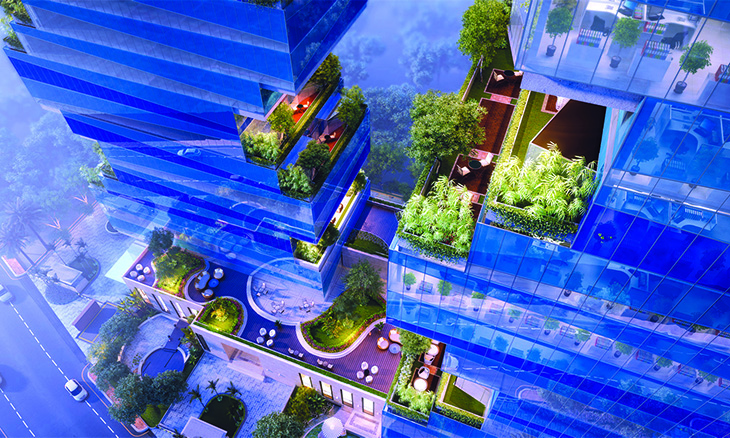Rising relevance of biophilic workplaces in India

In Bio Wonder, Kolkata, architectural ‘offsets’ are provided in the structure, allowing each office within the podium building to have a terrace for tree plantation. Courtesy: JLL Research.
The concept of ‘biophilia’ conveys that human beings have an inherent connection with nature due to their dependence on it for survival. This design incorporates natural elements like vegetation, water, natural light and ventilation. This increases occupants’ connectivity with nature.
This can be achieved by harnessing direct or indirect experiences of nature. Direct experience of nature refers to tangible contact with natural features. In contrast, the representations of nature, like images, natural materials, colours, shapes and geometries, can create an indirect experience.
In the post-pandemic workplace, well-being and employee retention have become increasingly important for companies. Presently, the level of social contact between employees has reduced compared to the pre-pandemic period which can lead to reduced feelings of collaboration and increased anxiety.
However, being surrounded by biophilic elements can reduce stress, lower blood pressure and steady the heart rate. And this can be seen reflecting on the employee’s performance and daily functioning.
Integration of biophilia with workspaces will have various benefits on health, well-being and environment which will in turn reduce the costs.
WELL standard
In recent times, the focus has shifted towards a more holistic interpretation of sustainability, which emphasizes on how indoor spaces support an occupant’s well-being.
The WELL building standard puts health and wellness at the centre of design and construction decisions, using biophilic design as a qualitative and quantitative metric. Listed below are a few office projects in India that have incorporated biophilic principles in their design.
The Gera Commerzone is a leading office park in Pune with a total development size of 4.2 million square feet, out of which 1.8 million square feet is completed. The campus is a new-age workspace designed for a millennial work force.
Some of the key elements used are, integrated recreational spaces with work spaces, reconnecting the millennial work force with nature, environmental sensitivity and segregating vehicular and pedestrian traffic.
Bio Wonder in Kolkata is the first biophilic corporate park in East India, having a total area of about 0.24 million square feet. Here, architectural ‘offsets’ are provided in the structure, allowing each office within the podium building to have a terrace for tree plantation.
The offsets also create shadow zones, cutting off scorching heat while facilitating rainwater harvesting and renewable energy production.
Biophilic design is at a very nascent stage in India, where its long-term challenges are yet to be explored. Concerns like high installation and maintenance costs might limit developers’ ability to implement it at a larger level in indoor spaces.
However, after weighing its benefits against the challenges, implementing biophilic design might have a long-lasting positive impact on the environment as well as occupants’ well-being in work places.

Comments

- Piergiorgio Pozzo on ‘dynamic’ saw blade balance
- Naadi boost digital transformation, innovation, growth
- IMALPAL’s solutions for perfect MDF lines
- Dieffenbacher develops fiberboard recycling technology
- Interzum Forum Italy makes its debut
- Craftsmanship in panel board production
- Unlocking versatility of Canadian wood species
- Rising relevance of biophilic workplaces in India
- China is at Europe’s doorstep, not India’s
- A good balance of quality and price
- 3D printer breaks Guinness World Record
- What is calibrated plywood?
- Viefe: where urban elegance meets craftsmanship
- Space-saving extensions from Häfele
- New sliding door system, hinge from Hettich
- Hymmen’s smart2i more than MES
- Veined marble coatings from ICA
- Feature-packed Optimus machines give you the edge
- Jowat sets new benchmark in flat lamination
- 5 applications of Luvih in home décor
- Another successful edition of Xylexpo concludes
- SCM goes beyond the machine at Xylexpo
- Giardina unveils new coating solutions
- Rehau celebrates Design Day with student architects
- Why you should head to Furtech (Dubai)
- Index Plus 2024: innovation in interiors, design
- Canadian Wood impresses budding architects
- Fimma + Maderalia 40th edition a runaway success
- Ligna 2025 will look beyond digitalisation, new products
- CIFF Guangzhou breaks records
- Thailand to host international furniture show in September
- HIFF prepared for September edition
- Event Calendar 2024
- Felder India organises Technology Days
- American species capture Aussie spirit
- ICA puts Bio panels through extremes
- Sculpted illusions brought to reality
- Making furniture with paper machines
- Natural sun protection for parquet, furniture
- Take some, give back more!
- AHEC initiates EUDR response mechanism
- Cefla powers Global Design to the big league
- If you have a problem, go to the Eibl joinery
- Egger counts on Hymmen tech for worktops
- Adaptable, practical hardware from Ozone
- Tendulkar is Hafele’s brand ambassador
- Dieffenbacher supports wood fibre research
- Spacewood takes off with shutters, carcasses, components
- Hyper: smart side pullout storage
- Brazed pre-milling cutters from Leitz
- Ornare panels in 12 new trending colours
- Mitol launches Vision Line adhesives
- Greenply honours craftsmanship
- Blum launches centre in Hyderabad
- Egger commissions recycling site in Italy
- Wooden Street opens plant in Jodhpur
- Century Plyboards starts new MDF factory
- Homag bags €90-m Chinese order
- Unicol celebrates factory expansion
- Hindware introduces Italian collection quartz
- Pietro Gheller heads SCM wood division
- New book on secrets of bonding








































